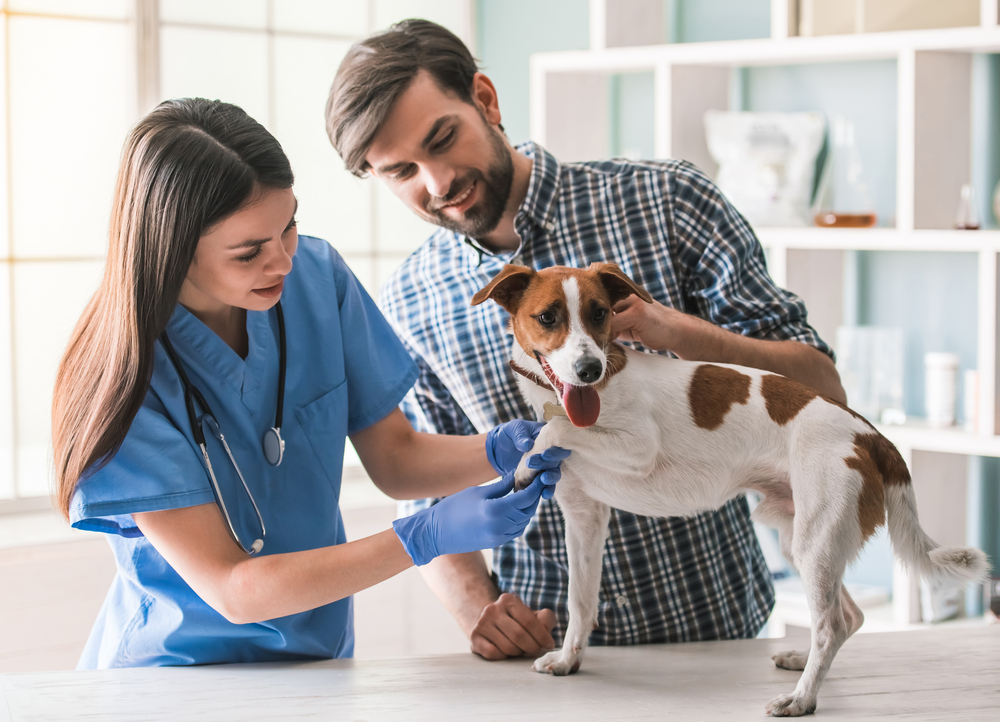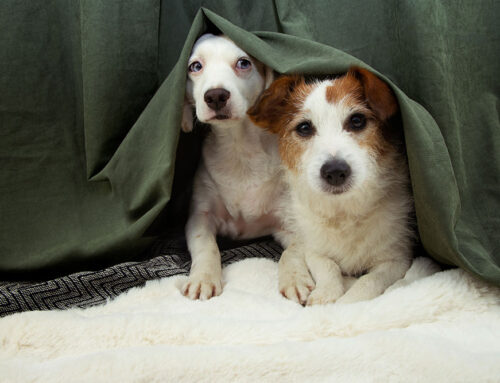Shivering, Sassy lost control of her urine and soaked the blankets in her crate. Her mouth bled as she bit the metal bars. She continued to bark and whine frantically, but her family would not return for another hour, and the thunderstorm raged on.
Unfortunately, Sassy’s reaction to the loud noise of the storm is not uncommon. The risk of noise phobia increases in the summer, when warm weather brings more outdoor activities, such as fireworks, and more loud thunderstorms. If your pet suffers from noise phobia, the Animal Clinic of Council Bluffs wants to help. Read on to better understand Sassy’s experience and to get helpful treatment tips.
“Sassy has always had a slightly ‘nervous disposition.’ She hates the vacuum cleaner, she doesn’t like being separated from us, and she seems to know before anyone else when a storm is approaching.”
Dogs like Sassy may be predisposed to develop noise phobia. Many dogs develop this condition slowly, although some are affected suddenly. Watch your pet for the early warning signs of anxiety, so we can intervene with treatment at an early stage, and decrease their suffering
“We felt terrible when we came home to find the aftermath of Sassy’s first major noise panic attack episode. We did not realize how severe her anxiety had become.”
“Panic attack” is an accurate phrase to describe many dogs’ reaction to loud noises. Affected pets may show any or all of the following signs of noise aversion:
- Licking lips
- Shaking
- Pacing
- Drooling
- Vocalizing
- Hiding
- Clinging
- Circling
- Pacing
- Panting
- Yawning
- Destroying furniture or crates
- Injuring themselves

“After her storm episode when she injured herself and tried to destroy her crate, we never wanted Sassy to experience that pain again. We came to the Animal Clinic of Council Bluffs for help.”
To help pets like Sassy, our first step is to take a thorough history and perform a physical examination. Next, we perform laboratory testing to help determine whether a pet has any underlying physical problems. Behavior modification is the most important arm of many pets’ treatment plans. Sometimes referral to a board-certified veterinary behaviorist is necessary, but our veterinarians and team are usually able to develop a plan, especially in the early stages of the condition. Our plan may include techniques such as distracting and redirecting when you are present during your pet’s episodes. We also may teach you how to help your pet through desensitization and counterconditioning.
“The team at Council Bluffs also taught us about supportive care and changes to Sassy’s environment that would help her noise anxiety. Most of these changes were simple and easy to make.”
Complementary therapy for pet noise aversion can include giving your pet calming supplements and using species-specific pheromones. Pet pheromones come in sprays and wipes, and can be used on or near a pet or in the environment to ease their fear. Some pets respond well to T-touch techniques and gear, or compression wear, such as thundershirts. Our team also can provide acupuncture and massage options. The Fear-Free Pets program provides information and helpful instruction about using calming colors, white noise, and soothing music.
“Sassy’s behavior modification treatment plan required the cooperation of our entire family, and really helped the situation. Ultimately, Sassy also required anti-anxiety medication for full relief.”
Sometimes, behavior modification and supportive therapies are not enough. Fortunately, effective prescription medication options also exist for pets. Sileo, a tranquilizer labeled for canine noise aversion, helps many of our patients. Sileo can be given situationally on days that noise is expected. For pets who need more anxiety relief, a daily medication such as clomipramine may work best. Remember that pets on long-term medication require regular wellness care to ensure their safety. Our team knows your pet and any underlying health conditions that may need continued monitoring.
The Animal Clinic of Council Bluffs can help if your pet suffers from noise phobia. Call for an appointment to discuss their condition. We will perform a thorough physical exam, obtain lab results, and formulate a customized treatment plan for them. Together, we will work to ensure your pet avoids Sassy’s difficult noise phobia experience.






Leave A Comment